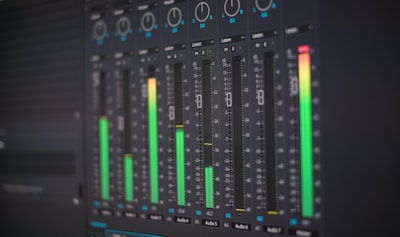Creating emotional soundscapes in video games
Creating emotional soundscapes in video games plays a crucial role in gaming, immersing players and enhancing their experience. It provides cues about the surroundings and adds depth to the storyline. A well-crafted soundtrack heightens tension, ambient sounds create realism, and also voice acting adds personality. Sound design is integral to gaming and should not be overlooked. Developers who prioritize high-quality audio can create a more memorable and enjoyable experience for players.

Understanding the Soundscape in Gaming
Audio is crucial in gaming, enhancing immersion and emotional responses. Crafting a game’s soundscape involves understanding the narrative, mechanics, and aesthetic vision. Sound designers use various techniques like Foley recording and synthesizers to create immersive experiences. Music sets the tone and mood of gameplay scenarios. Collaboration between sound designers, composers, and developers ensures audio complements visuals for an unforgettable gaming experience. As technology advances and virtual reality grows, audio will play an even more significant role in creating immersive gameplay.
Realism and Immersion
Realism is a crucial element for enhancing a player’s sense of presence in a game. One way to achieve this is by utilizing digital audio to create a lifelike game world. Footsteps and environmental sounds are especially important as they can significantly impact immersion. Real-time audio, which adjusts based on the player’s actions, can further enhance the gameplay experience. By incorporating these elements, developers can create a more immersive and also engaging game that transports players into another world. Additionally, realistic audio can also help with spatial awareness and provide valuable cues for players to make strategic decisions during gameplay.
Parameters and Repetition
In gaming, audio plays a crucial role in the overall experience. Striking a balance between realism and repetition is important in sound design. Variety and consistency are also necessary, as too much repetition can lead to boredom. It’s vital to introduce new challenges and environments to avoid monotony. Game developers must pay close attention to sound design, matching it with the game’s style and tone. They should consider how different sound effects interact and impact gameplay. A well-crafted audio experience enhances player immersion and enjoyment.
Game Development Audio Engines
Wwise and FMOD are popular audio engines used in modern gaming. They offer developers a wide range of tools to create immersive soundscapes that enhance the gaming experience. These engines enable surround sound, which is crucial for virtual reality and 3D audio. Compatibility is also important as games are developed for multiple platforms. Wwise and FMOD have excellent compatibility with different platforms, ensuring seamless performance across devices.
Emitters and Ambience
Emitters play a pivotal role in audio placement, particularly when creating immersive soundscapes. With emitters, it’s possible to create realistic ambient sounds like the rustling of leaves, footsteps, and other environmental noise that can set the mood for a scene. A well-crafted soundtrack and game music can also be used to enhance storytelling by creating tension and emotional resonance. Understanding how to use emitters effectively and integrate them with your sound design is crucial for creating an engaging audio experience that immerses players in the game world.
Taking Your Sound Design to New Heights
The First Steps in Sound Design
To start a career as a sound designer, follow these steps: acquire necessary skills and tools, such as Pro Tools or Logic Pro, learn sound theory and design principles, gain practical experience through small projects or collaborations, network and stay updated on industry trends by attending conferences and joining online communities, build a portfolio showcasing your work, and consistently improve your skills through practice and feedback. With dedication and passion for sound design, you can make your dream a reality.
Creating Emotional Impact
Sound is vital in creating a memorable gaming experience, especially in horror games. It can intensify the atmosphere and evoke fear, tension, and anxiety in players. Various sound effects like creaky doors, footsteps, and eerie music can create an immersive environment that heightens dread. Audio storytelling with voice acting and narration adds depth to characters and enhances the plot. This emotional connection between players and the game world leaves a lasting impact on their memory. Game developers must prioritize audio design as it can make or break the player’s experience. A well-crafted soundscape elevates a game from good to unforgettable.
How do you add ambience to a game?
Creating an immersive and authentic experience for players is crucial in game development. One key aspect of achieving this is by adding ambiance to the game. This can be accomplished through the use of sound effects, background music, lighting, and environmental design. Well-executed ambiance can transport players to the game’s world and make them feel like they are a part of it. It also enhances the emotional impact of the gameplay and makes it more enjoyable for players.
How does music trigger emotions?
Music has a remarkable ability to evoke emotions within us. It taps into our subconscious and connects with our deepest feelings. The combination of melody, rhythm, harmony, and dynamics can create a powerful emotional response. Different musical elements can elicit various emotions. For example, a slow and melancholic melody may evoke sadness or nostalgia, while fast-paced and energetic beats might elicit excitement or joy.
Why is sound design important in video games?
Sound design is an integral part of video game development. It plays a crucial role in enhancing the player’s experience and immersing them in the game world. Sound effects such as footsteps, explosions, or creaky doors add realism and make the gameplay more engaging. Environmental sounds like rain, wind, or birds chirping create a sense of presence and help players connect with the virtual environment.
What makes an effective game music soundtrack?
An effective game music soundtrack is one that complements the gameplay and enhances the player’s emotional journey. It should be carefully crafted to fit the theme, setting, and narrative of the game. A good soundtrack should have a strong melodic structure that is memorable yet not distracting. It should also have dynamic range, adapting to different gameplay situations to create tension or provide moments of respite.
What is dynamic music in video games?
Dynamic music in video games refers to music that adapts and changes based on the player’s actions or the game’s events. It is designed to enhance the gameplay experience by creating a seamless integration between the music and the game mechanics. Dynamic music can adjust its tempo, intensity, or instrumentation in real-time, matching the pace and mood of the gameplay.
What is the study of video game music called?
The study of video game music is called ludomusicology. Ludomusicologists examine the role of music in video games, analyzing how it contributes to gameplay, narrative, and player experience. They explore various aspects of game music, from composition techniques to interactive and adaptive elements, aiming to understand its impact on players.
Conclusion
Sound design is crucial in video game development. It enhances the immersive experience and evokes emotions. Developers must prioritize sound design to create memorable games. Working with experienced sound designers can make a significant difference in immersing players in a game world and creating unforgettable gaming experiences.
Follow on Instagram.

